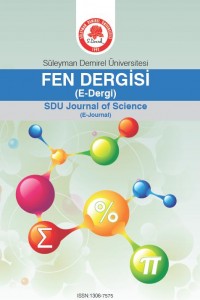Abstract
In this study, hardness values of borided low carbon microalloyed steels were measured. The boronizing treatment was performed at 1123 K under various exposure times using Ekabor-II commercial powders. The presence of FeB and Fe2B phases in the boride layer of the boronized low carbon microalloyed steels were observed using an X-ray diffractometer and energy dispersive spectroscopy (EDS) analysis. It was concluded that boride layer thickness and hardness values increase with increasing boriding time due to hard boride phases and diffusion as a result of boronizing process
References
- Onaran K., NARAN K, 2000. Malzeme Bilimi, Bilim Teknik Yayınevi, İstanbul.
- Kong J., Xie C., 2006. Effect of molybdenum on continuous cooling bainite transformation of low-carbon microalloyed steel, Materials and Design, 27: 1169-1173.
- Sinha A.K., 1991. Boriding (boronizing). In: ASM Int Handbook, vol. 4. Materials Park, OH, USA: The Materials International Society; pp. 437–447.
- Atik A., Yunker E., Meric C., 2003. The effects of conventional heat treatment and boronizing on abrasive wear and corrosion of SAE 1010, SAE 1040, D2 and 304 steels, Tribology International, 36, 155-161.
- Bektes M., Calik A., Ucar N., Keddam M., 2010. Pack-boriding of Fe–Mn binary alloys: Characterization and kinetics of the boride layers, Materials Characterization, 61: 233-239.
- Brakman C.W., Gommers A.W.J., Mittemeijer E.J., 1989. Bonding of Fe and Fe-C, Fe-Cr, and Fe-Ni alloys; Boride-layer growth kinetics, Journal of Materials Research, 4: 1354-1370.
- Celikyurek I., Baksan B., Torun O., Gurler R., 2006. Boronizing of iron aluminide Fe72Al28 , Intermetallics, 14: 136-141.
- Nair F., Karamis M. B., 1997. Borlanmış Çeliklerde Malzeme Bileşiminin Mikrosertliğe Etkileri, 7. Denizli Malzeme Sempozyumu, DENİZLİ, TÜRKİYE, s 354-360.
- Li C., Shen B., Li G., Yang C., 2008. Effect of boronizing temperature and time on microstructure and abrasion wear resistance of Cr12Mn2V2 high chromium cast iron, Surface&Coatings Technology, 202: 5882-5886.
Abstract
Özet: Bu çalışmada, borlanan düşük karbonlu çeliklerin sertlik değerleri ölçülmüştür. Borlama işlemi 1123 K sıcaklıkta ve değişik sürelerde ticari ekabor-II tozları kullanılarak gerçekleştirilmiştir. Yapılan X Işınları Kırınımı (XRD) ve Enerji Dağınım Spektroskopisi (EDX) analizleri ile borlanan düşük karbonlu mikroalaşımlı çeliklerin borür tabakasında FeB ve Fe2B fazlarının oluştuğunu gözlenmiştir. Borlama işleminin bir neticesi olarak difüzyon ve oluşan sert bor fazlar yüzünden, borlama süresi ile borür tabakası kalınlığı ve sertlik değerlerinde bir artışın olduğu sonucuna varılmıştır.
Anahtar kelimeler: Ekabor, XRD, EDX, difüzyon, FeB, Fe2B
The Effect of Boriding Time on Hardness Values of Low Carbon Micro Alloyed Steels
Abstract: In this study, hardness values of borided low carbon microalloyed steels were measured. The boronizing treatment was performed at 1123 K under various exposure times using Ekabor-II commercial powders. The presence of FeB and Fe2B phases in the boride layer of the boronized low carbon microalloyed steels were observed using an X-ray diffractometer and energy dispersive spectroscopy (EDS) analysis. It was concluded that boride layer thickness and hardness values increase with increasing boriding time due to hard boride phases and diffusion as a result of boronizing process.
Key words: Ecabor, XRD, EDX, diffusion, FeB, Fe2B
References
- Onaran K., NARAN K, 2000. Malzeme Bilimi, Bilim Teknik Yayınevi, İstanbul.
- Kong J., Xie C., 2006. Effect of molybdenum on continuous cooling bainite transformation of low-carbon microalloyed steel, Materials and Design, 27: 1169-1173.
- Sinha A.K., 1991. Boriding (boronizing). In: ASM Int Handbook, vol. 4. Materials Park, OH, USA: The Materials International Society; pp. 437–447.
- Atik A., Yunker E., Meric C., 2003. The effects of conventional heat treatment and boronizing on abrasive wear and corrosion of SAE 1010, SAE 1040, D2 and 304 steels, Tribology International, 36, 155-161.
- Bektes M., Calik A., Ucar N., Keddam M., 2010. Pack-boriding of Fe–Mn binary alloys: Characterization and kinetics of the boride layers, Materials Characterization, 61: 233-239.
- Brakman C.W., Gommers A.W.J., Mittemeijer E.J., 1989. Bonding of Fe and Fe-C, Fe-Cr, and Fe-Ni alloys; Boride-layer growth kinetics, Journal of Materials Research, 4: 1354-1370.
- Celikyurek I., Baksan B., Torun O., Gurler R., 2006. Boronizing of iron aluminide Fe72Al28 , Intermetallics, 14: 136-141.
- Nair F., Karamis M. B., 1997. Borlanmış Çeliklerde Malzeme Bileşiminin Mikrosertliğe Etkileri, 7. Denizli Malzeme Sempozyumu, DENİZLİ, TÜRKİYE, s 354-360.
- Li C., Shen B., Li G., Yang C., 2008. Effect of boronizing temperature and time on microstructure and abrasion wear resistance of Cr12Mn2V2 high chromium cast iron, Surface&Coatings Technology, 202: 5882-5886.
Details
| Primary Language | Turkish |
|---|---|
| Subjects | Metrology, Applied and Industrial Physics |
| Journal Section | Makaleler |
| Authors | |
| Publication Date | December 31, 2014 |
| Published in Issue | Year 2014 Volume: 9 Issue: 2 |

